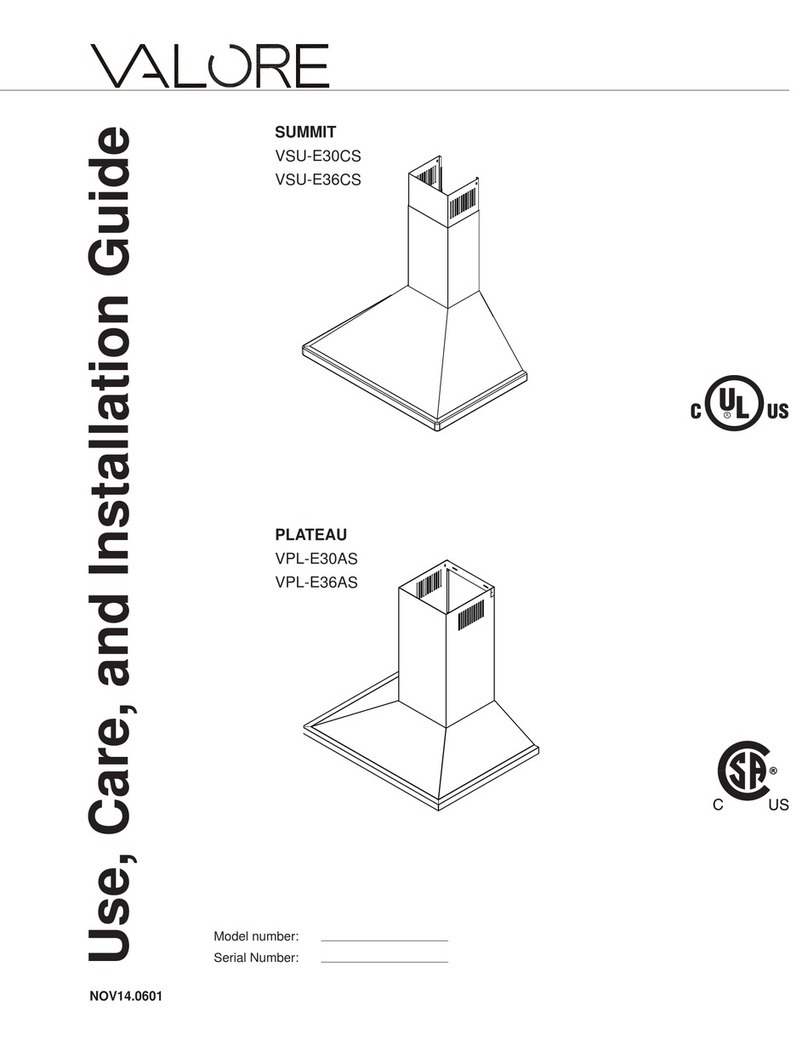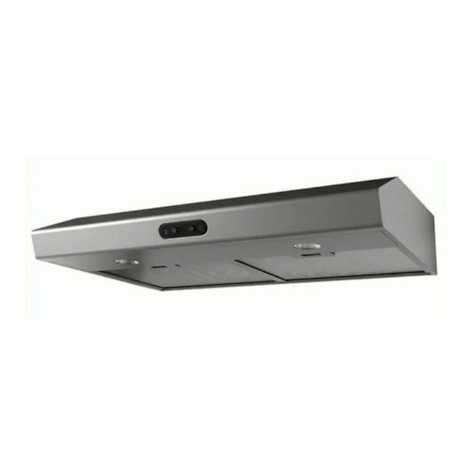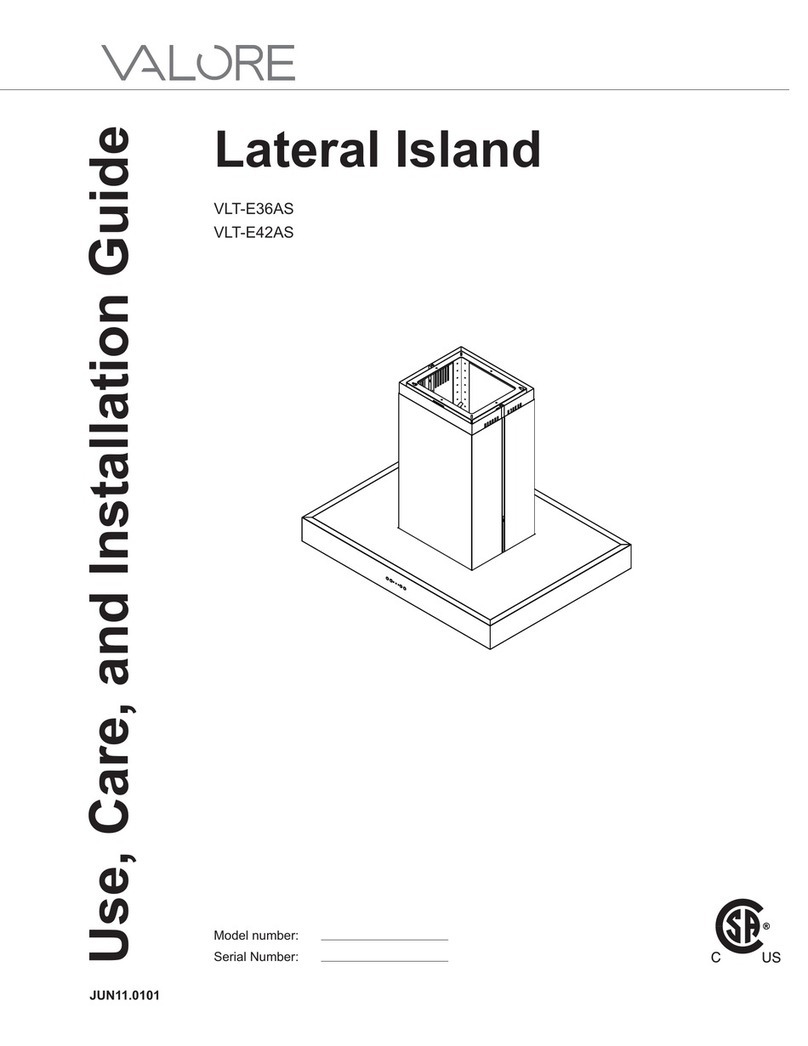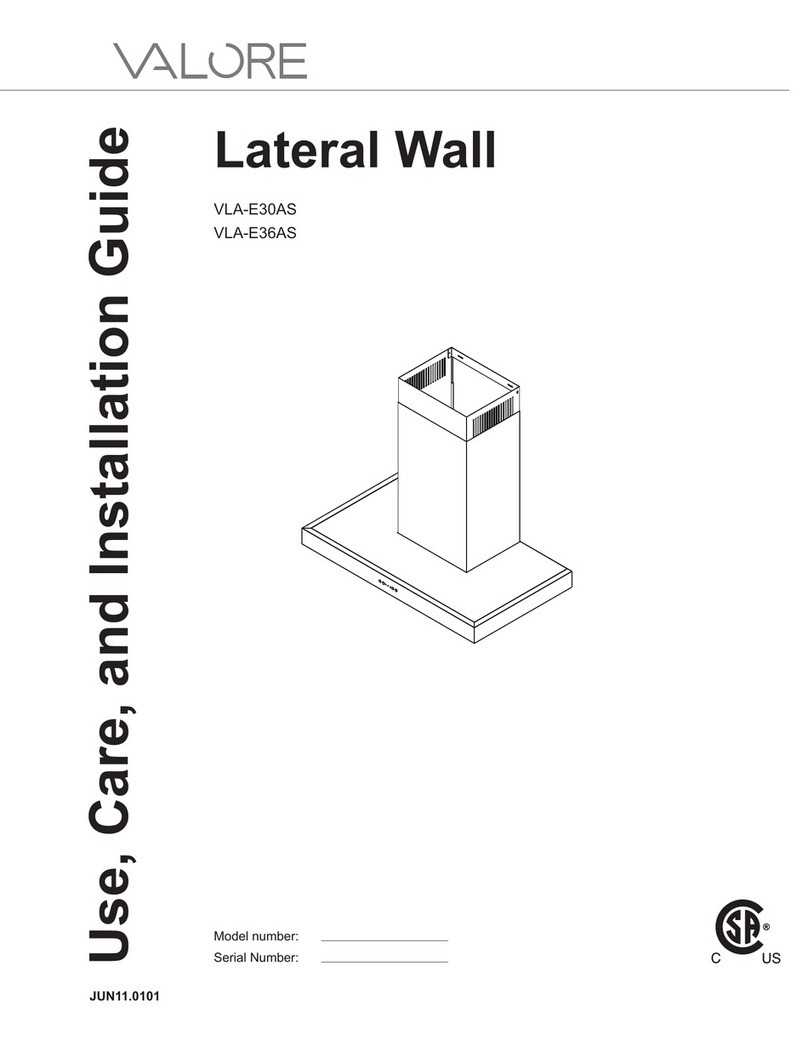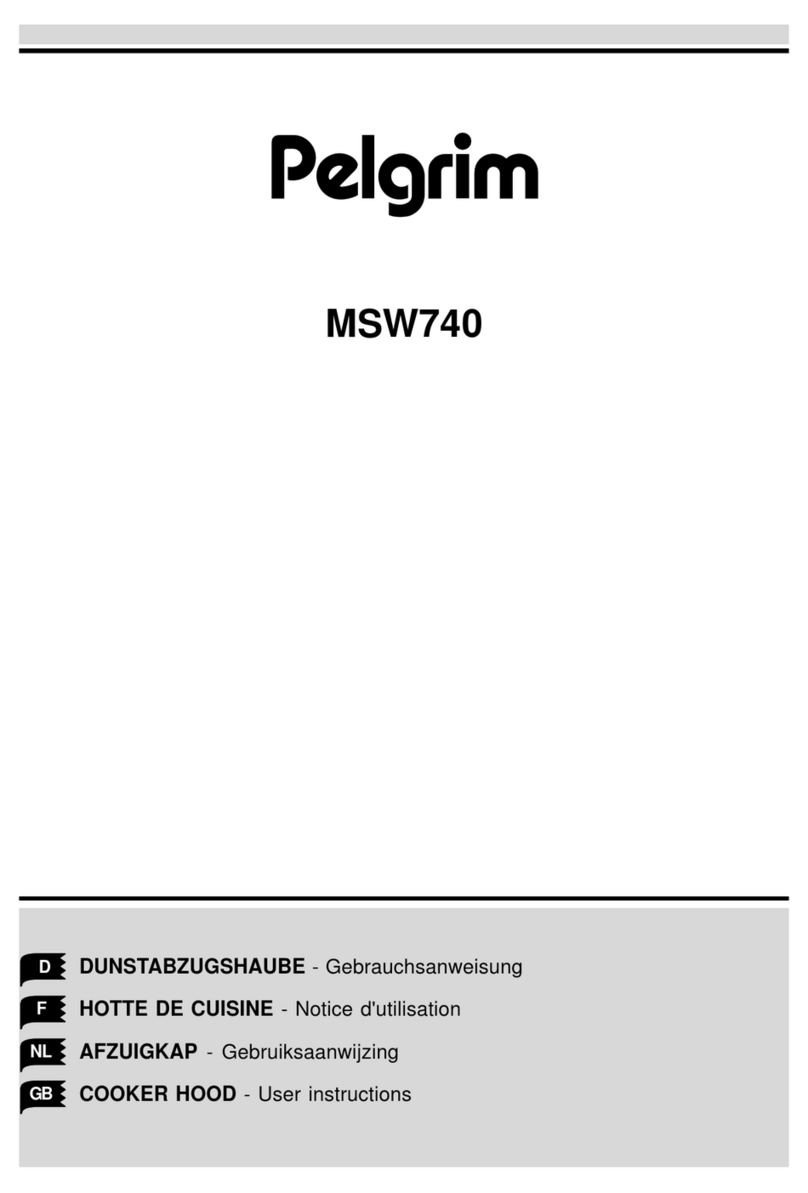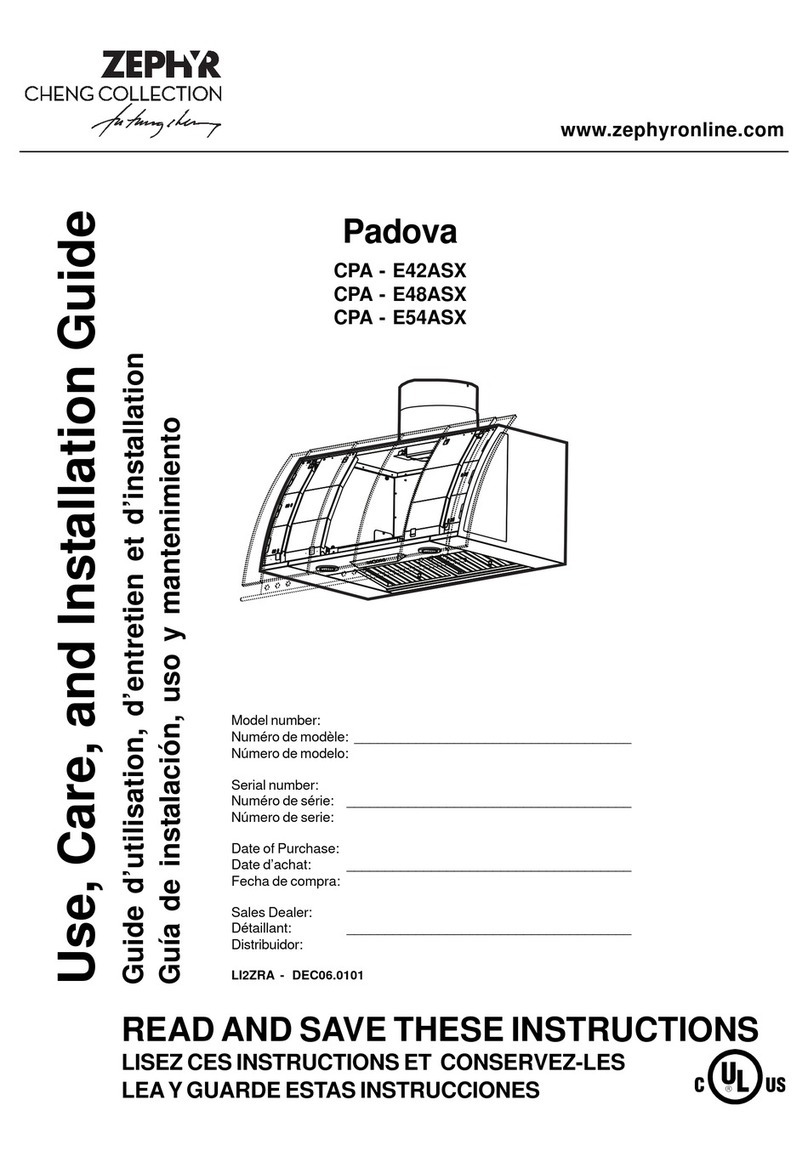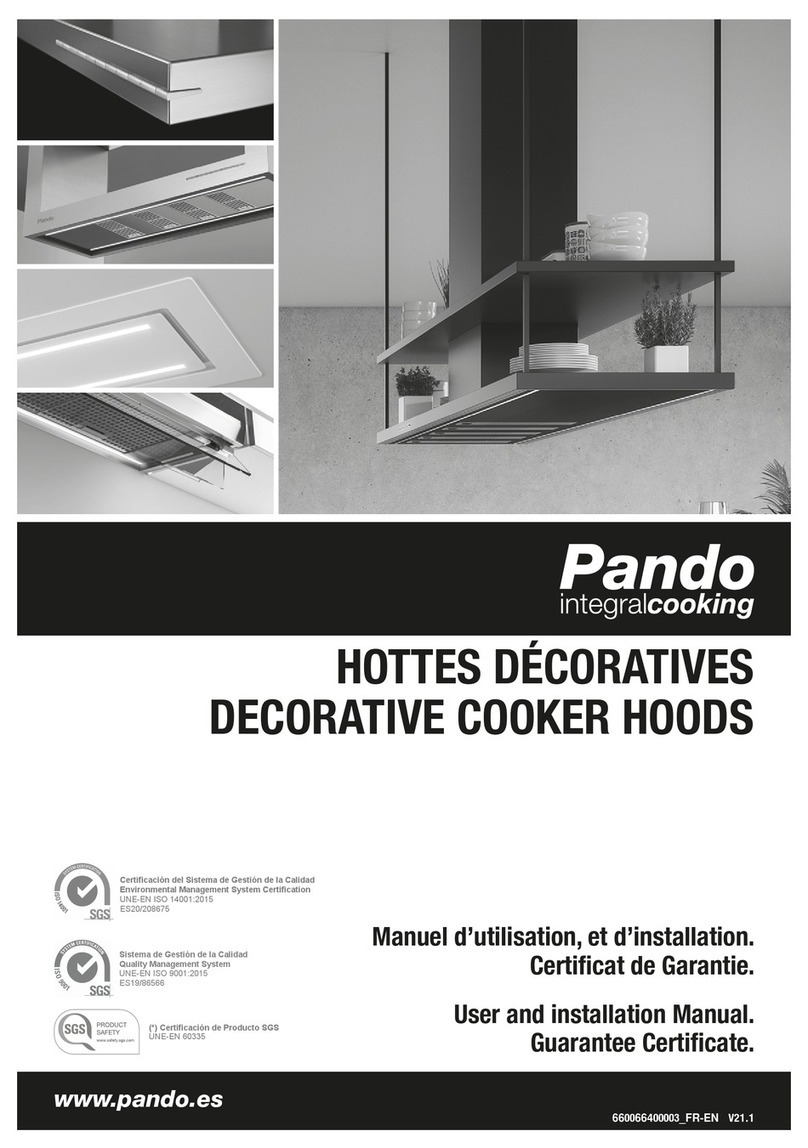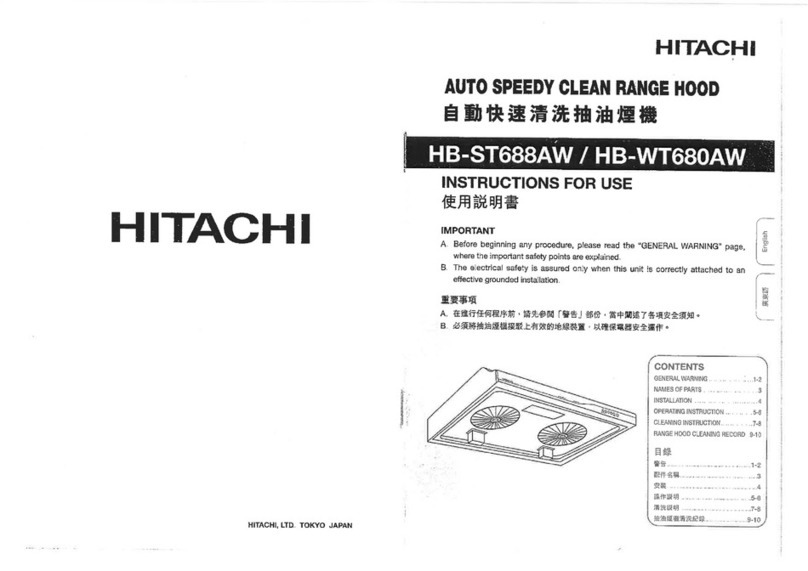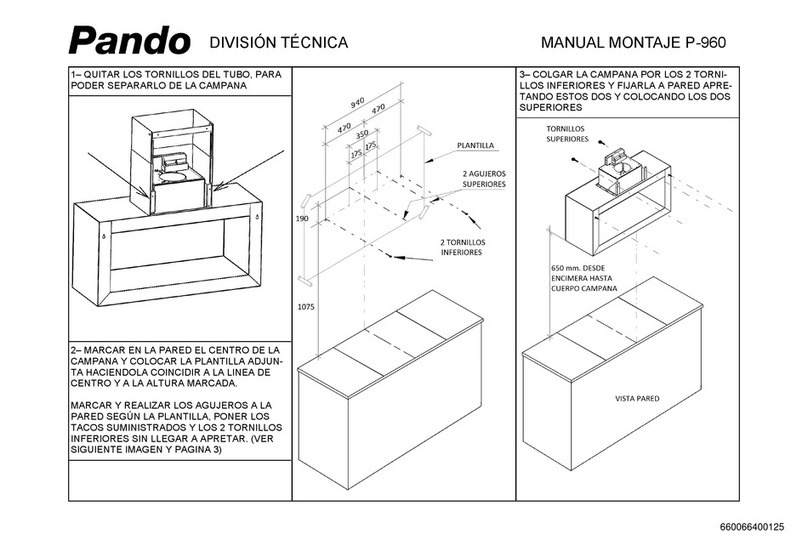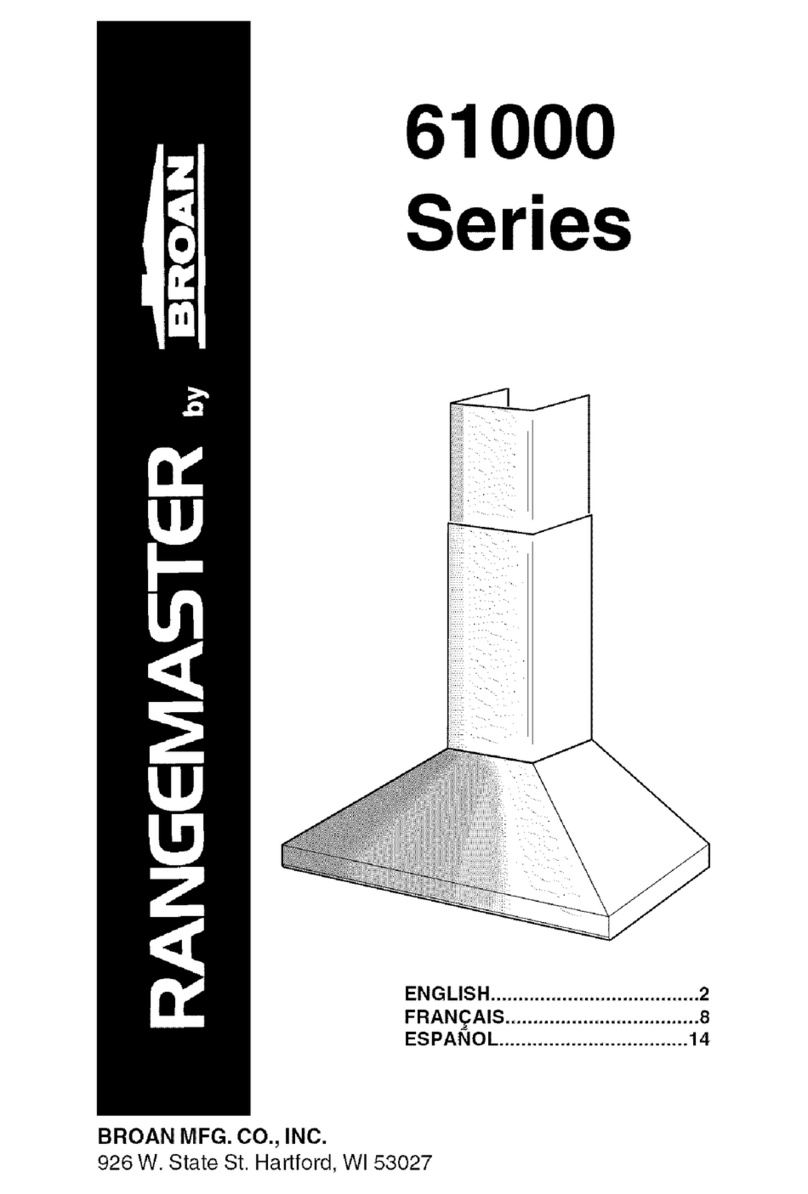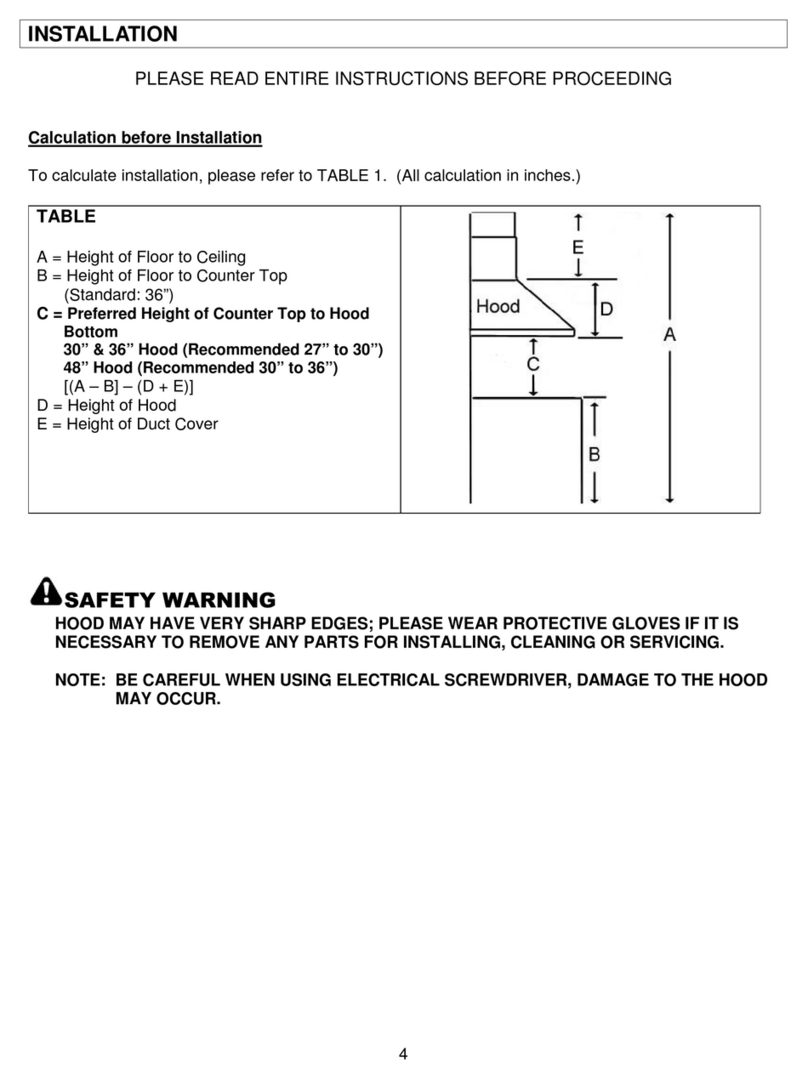Valore VSU-E30AS Installation guide

Use, Care, and Installation Guide
Model number:
Serial Number:
PLATEAU
VPL-E30AS
VPL-E36AS
SUMMIT
VSU-E30AS
VSU-E36AS
CRESCENT
VCR-E30AG
VCR-E36AG
AUG12.0401


1
SAFETY NOTICE ................................................................. 2-3
LIST OF MATERIALS....................................................... 4
INSTALLATION
Ducting Calculation Sheet....................................... 5
Mounting Height & Clearance................................ 6
Ducting Options ........................................................... 7
Hood Specifications ................................................... 8-10
Mounting the Hood VSU .......................................... 11
Mounting the Hood VPL................................. 12
Mounting the Hood VCR................................. 13
Ductless Recirculating .............................................. 14
FEATURES & CONTROLS
Mechanical Controls, VSU...................................... 15
Electronic Controls, VPL and VCR...................... 16
MAINTENANCE
Hood and Filter Cleaning......................................... 17
Light Bulbs ..................................................................... 18
TROUBLESHOOTING................................................................ 19
LIST OF PARTS AND ACCESSORIES .............................. 20
Table of Contents

Important Safety Notice
READ AND SAVE THESE INSTRUCTIONS
2
WARNING
TO REDUCE THE RISK OF FIRE OR ELECTRIC SHOCK, DO NOT USE THIS FAN WITH ANY SOLID-STATE CONTROL DEVICE.
WARNING
TO REDUCE THE RISK OF FIRE ELECTRIC SHOCK, OR INJURY TO PERSONS, OBSERVE THE FOLLOWING:
a. Use this unit only in the manner intended by the manufacturer, if you have questions, contact the manufacturer.
b. Before servicing or cleaning unit, switch power off at service panel and lock panel to prevent power from being switched on accidentally.
When the service disconnecting means cannot be locked, securely fasten a prominent warning device, such as a tag, to the service
panel.
CAUTION
For general ventilating use only. Do not use to exhaust hazardous or explosive materials and vapors. Take care when using cleaning
agents or detergents. Suitable for use in household cooking area.
WARNING
TO REDUCE THE RISK OF RANGE TOP GREASE FIRE:
a. Never leave surface units unattended at high settings. Boilovers cause smoking and greasy spillovers that may ignite. Heat oils slowly
on low or medium settings.
b. Always turn hood ON when cooking at high heat or when flaming food
c. Clean ventilating fans frequently. Grease should not be allowed to accumulate on fan or filter.
d. Use proper pan size. Always use cookware appropriate for the size of the surface element.
e. Keep fan, filters and grease laden surfaces clean.
f. Use high setting on hood only when necessary.
g. Don’t leave hood unattended when cooking.
h. Always use cookware and utensils appropriate for the type of and amount of food being prepared.
WARNING
TO REDUCE THE RISK OF INJURY TO PERSONS IN THE EVENT OF A RANGE TOP FIRE, OBSERVE THE FOLLOWING:
a. SMOTHER FLAMES with a close-fitting lid, cookie sheet, or metal tray, then turn off the burner. BE CAREFUL TO PREVENT BURNS.
If the flames do not go out immediately, EVACUATE AND CALL THE FIRE DEPARTMENT.
b. NEVER PICK UP A FLAMING PAN – You may be burned.
c. DO NOT USE WATER, including wet dishcloths or towels – a violent steam explosion will result.
d. Use an extinguisher ONLY if:
1. You know you have a Class ABC extinguisher, and you already know how to operate it.
2. The fire is small and contained in the area where it started.
3. The fire department is being called.
4. You can fight the fire with your back to an exit
WARNING
TO REDUCE THE RISK OF FIRE, ELECTRIC SHOCK OR INJURY TO PERSONS, OBSERVE THE FOLLOWING:
a. Installation work and electrical wiring must be done by qualified person(s) in accordance with all applicable codes and standards.
Including fire-rated construction.
b. Sufficient air is needed for power combustion and exhausting of gases through the flue (chimney) of fuel burning equipment to prevent
back-drafting. Follow the heating equipment manufacturer’s guideline and safety standards such as those published by the National
Fire Protection Association (NFPA) and the American Society for Heating, Refrigeration and Air Conditioning Engineers (ASHRAE) and
the local code authorities.
c. When cutting or drilling into wall or ceiling, do not damage electrical wiring and other hidden utilities.
d. Ducted fans must always vent to the outdoors.
e. NEVER place a switch where it can be reached from a tub or shower.
f. Make sure the power is off before installing, wiring or maintenancing.

Important Safety Notice
3
WARNING
TO REDUCE THE RISK OF FIRE, USE ONLY METAL DUCTWORK.
CAUTION
To reduce risk of fire and to properly exhaust air outside - Do not vent exhaust air into spaces within walls, ceilings,
attics, crawl spaces or garages.
OPERATION
Always leave safety grilles and filters in place. Without these components, operating blowers could catch onto hair, fingers
and loose clothing.
The manufacturer declines all responsibility in the event of failure to observe the instructions given here for installation,
maintenance and suitable use of the product. The manufacturer further declines all responsibility for injury due to
negligence and the warranty of the unit automatically expires due to improper maintenance.
ELECTRICAL REQUIREMENTS
Important:
Observe all governing codes and ordinances.
It is the customer’s responsibility:
- To contact a qualified electrical installer.
- To assure that the electrical installation is adequate and in conformance with National Electrical Code, ANSI/NFPA 70
latest edition* or CSA standards C22.1-94, Canadian Electrical Code, Part 1 and C22.2 No.0-M91 - latest edition** and
all local codes and ordinances.
If codes permit and a separate ground wire is used, it is recommended that a qualified electrician determine that the
ground path is adequate.
Do not ground to a gas pipe.
Check with a qualified electrician if you are not sure the range hood is properly grounded.
Do not have a fuse in the neutral or ground circuit.
*National Fire Protection Association Batterymarch Park, Quincy, Massachusetts 02269
** CSA International 8501 East Pleasant Valley Road, Cleveland, Ohio 44131-5575
This appliance requires a 120V 60Hz electrical supply and connected to an individual properly grounded branch circuit
protected by a 15 or 20 ampere circuit breaker or time delay fuse. Wiring must be 2 wire with ground. Please also refer to
Electrical Diagram on product.
A cable locking connector (not supplied) might also be required by local codes. Check with local requirements, purchase
and install appropriate connector if necessary.
VSU, VPL and VCR - 400 Watts, 3.3 Amps

List of Materials
4
(3) Wire Nuts
(3) M4 x 1-1/2” (2) M4 x 1”
(4) 3/16” x 8
(VCR Only)
(4) M3.5 x 8
PARTS NOT SUPPLIED
- Ducting, conduit and all installation tools
- Cable connector (if required by local codes)
- Extension duct cover accessory
- Recirculating kit accessory
HARDWARE PACKAGE CONTENTS
(1) Suction Cup
PARTS SUPPLIED
MODELS: VSU, VPL, VCR
1 - Hood with internal blower
1 - Duct cover wall bracket
1 - Duct cover assembly (top and bottom)
1 - Hardware package
1 - 6” round backdraft damper (pre-installed)
2 - 50W GU-10 halogen light bulbs
2 - Aluminum mesh filters
1 - Canopy, glass (VCR models only)

5
Duct pieces To t a l
Equivalent number
length x used =
3-1/ 4” x 10”
Rect.,
straight
1 Ft. x ( ) = Ft.
8” Round,
straight
1 Ft. x ( ) = Ft.
3-1/ 4” x 10”
Rect.900
elbow
15 Ft. x ( ) = Ft.
3-1/ 4” x 10”
Rect.450
elbow
9 Ft. x ( ) = Ft.
3-1/ 4” x 10”
Rect.900
flat elbow
24 Ft. x ( ) = Ft.
3-1/ 4” x 10”
Rect.
wall cap
with damper
30 Ft. x ( ) = Ft.
3-1/ 4” x 10”
Rect.to
6” round
transition
5 Ft. x ( ) = Ft.
3-1/ 4” x 10”
Rect.to
6” round
transition
900 elbow
20 Ft. x ( ) = Ft.
6” Round,
900 elbow
15 Ft. x ( ) = Ft.
6” Round,
450 elbow
9 Ft. x ( ) = Ft.
Ft.
7” Round,
straight
1 Ft. x ( ) = Ft.
Subtotal column 1 =
Duct pieces To t a l
Equivalent number
length x used =
6”- 8”Round
wall cap
with damper
30 Ft. x ( ) = Ft.
Round
wall cap
with damper
30 Ft. x ( ) = Ft.
7” or 8”
Round,
900elbow
15 Ft. x ( ) = Ft.
7” or 8”
7” or 8”
Round,
450
elbow
9 Ft. x ( ) = Ft.
Ft.
Ft.
Ft.
6”- 8” Round,
roof cap
30 Ft. x ( ) = Ft.
7” or 8”
Round,
roof cap
30 Ft. x ( ) = Ft.
Subtotal column 2 =
Subtotal column 1 =
Total ductwork =
Maximum Duct Length: For satisfactory air movement,
the total duct length of a 3 1/ 4” x 10” rectangular 6” or 7”
diameter round duct should not exceed 100 equivalent feet.
6” round to
3-1/ 4” x 10”
rect.
transition
1 Ft. x ( ) = Ft.
6” round to
3-1/ 4” x 10”
rect.
transition
900 elbow
16 Ft. x ( ) = Ft.
7” round to
3 1/ 4” x 10”
rect.
transition
8 Ft. x ( ) = Ft.
7” round to
3-1/ 4” x 10”
rect.
transition
900 elbow
23 Ft. x ( ) = Ft.
Installation – Ducting Calculation Sheet

Installation – Mounting Height & Clearance
6
DUCTING
A minimum of 6” round duct must be used to
maintain maximum air flow efficiency.
Always use rigid type metal ducts only. Flexible
ducts could restrict air flow by up to 50%.
Use calculation worksheet to compute total duct
work (Page 5).
ALWAYS, when possible, reduce the number of
transitions and turns. If a long duct run is required,
increase duct size from 6” to 7” or 8”.
If turns or transitions are required: Install as far
away from duct opening and as far apart between
the two transitions as possible.
Minimum mount height between range top to hood
bottom should be no less than 26”.
Maximum mount height should be no higher than
34”.
It is important to install the hood at the proper
mounting height. Hoods mounted too low could
result in heat damage and fire hazard; while hoods
mounted too high will be hard to reach and will
loose its performance and efficiency.
If available, also refer to range manufacturer’s
height clearance requirements and recommended
hood mounting height above range. Always check
your local codes for any differences.
Chart 1
VSU VPL VCR
(A) 27-1/2” 27” 23”
(B) 32” 31” 27”
(C) 42-1/2” 48” 42”
(D) 89-1/2” 89” 85”
(E) 112-1/2” 118” 112”
Duct cover extension kit available for ceiling
heights up to 12 feet. Turn to page 20 for part
number and ordering information.
DAMAGE-SHIPMENT / INSTALLATION:
• Please fully inspect unit for damage before
installation.
• If the unit is damaged in shipment, return the
unit to the store in which it was bought for
repair or replacement.
• If the unit is damaged by the customer, repair
or replacement is the responsibility of the
customer.
• If the unit is damaged by the installer (if other
than the customer), repair of replacement must
be made by arrangement between customer
and installer.
36”
** Min. (D)
Max. (E)
* Refer to Chart 1 on this page for actual hood heights.
** For minimum recirculating ceiling height add 4”
* Min. ducted (A)
Min. recirc. (B)
Max. (C)
Min 26” - Max. 34”

7
WARNING FIRE HAZARD
NEVER exhaust air or terminate duct work into spaces between walls, crawl spaces, ceiling, attics or garages.
All exhaust must be ducted to the outside, unless using the recirculating option.
Use single wall rigid Metal ductwork only.
Fasten all connections with sheet metal screws and tape all joints w/ certified Silver Tape or Duct Tape.
Some Ducting Options
Installation – Ducting Options
side wall cap
w/ gravity damper
Soffit or crawl space
Roof Pitch w/
Flashing & Cap
ductless
recirculating
side wall cap
w/ gravity damper
(blower
housing)
(blower
housing)
(blower
housing)
(blower
housing)

8
Installation – VSU Hood Specifications
2#
22
9
#
24
27
#
48
27
#
3:
26
27
#
94
5
#
78
9
#
23#
2:
4
5
#
52/4±
46 8
9
#
-
Standard Duct Cover
Min. ducted 27
1/2
”
Min. recirc. 32”
Max. ducted 42
1/2
”
V1C-00SU Extension
Min. ducted 46
1/2
”
Min. recirc. 50
1/2
”
Max. ducted 80”

9
Installation – VPL Hood Specification
48
9
#
7ȹ
21
4
9
#
4641ȹ-8
27
#
2
4
27
#
21
6
9
#
33
2!ȹ
27
66
27
#
29 8
27
#
Standard Duct Cover
Min. ducted 27”
Min. recirc. 31”
Max. ducted 48”
V1C-00PL Extension
Min. ducted 43
1/2
”
Min. recirc. 47
1/2
”
Max. ducted 81”

10
Installation – VCR Hood Specification
34
26
27
#
21
4
9
#
4641ȹ-4
27
#
48
9
#
21
6
9
#
2:
4
5
#
7ȹ
Standard Duct Cover
Min. ducted 23”
Min. recirc. 27”
Max. ducted 42”
V1C-00CR Extension
Min. ducted 41
1/2
”
Min. recirc. 45
1/2
”
Max. ducted 80”
26 8
27
#

11
1. Measure from range top to hood bottom and mark line A.
(26” minimum from range top) .
2. Plum and mark center line.
3. Mark mounting height line B. (12” from line A)
4. Mark mounting spread from C/L on line B. From center
line to left mount mark (3-1/2”). From center line to right
mount mark (2”).
5. Fasten (2) M4x1-1/4” screws into studs on line B. Do not
fasten screws all the way. Note: wood blocking may
need to be added behind the drywall if no studs are
present. Wall anchors may also be used but check
local codes for compliance. Failure to use suitable
wall anchors and screws to hold the weight of the
hood could result in personal injury or damage to
cooking sureface or counter.
6. Hang hood onto screws and hand tighten. (Fig.A) Use
the last M4x1-1/4” screw to further secure the hood to
the wall from inside the hood.
7. Center and attach duct cover bracket to wall below
ceiling or soffit using (2) M4x1” screws.
8. Install electrical.
9. *Install duct work and duct tape.
10. Power up hood and check for leaks around duct tape.
11. Place telescopic duct covers onto hood and extend
inner (top) duct cover upwards and secure to duct cover
bracket using (2) M4x3/8” screws.
*if using hood in recirculating mode you must secure air
diverter plate onto wall before installing duct work and
duct covers. Turn to page 14 for more details.
A
B
C/L
12"
C/L
26" min
fig. A
Duct Cover Bracket
2"3-1/2"
WARNING: Electrical wiring must be done by a qualified person(s) in
accordance with all applicable codes and standards. This range hood must be
properly grounded. Turn off electrical power at service entrance before wiring.
!
Cable Lock
Cable Lock
A cable locking connector (not supplied) might
be required by local codes. Check with local
requirements and codes, purchase and install
appropriate connector if necessary.
CAUTION: At least two installers are
required due to the weight and size of the
hood.
!
Installation – Mounting the Hood VSU

12
1. Measure from range top to hood bottom and mark line A.
(26” minimum from range top) .
2. Plum and mark center line.
3. Mark mounting height line B. (16-7/16” from line A)
4. Mark mounting spread from C/L. (8-7/8”)
5. Fasten (2) M4 x 1-1/2” screws into studs on line B but
do not tighten all the way. Note: wood blocking may
need to be added behind the drywall if no studs are
present. Wall anchors may also be used but check
local codes for compliance. Failure to use suitable
wall anchors and screws to hold the weight of the
hood could result in personal injury or damage to
cooking sureface or counter.
6. Remove the (2) metal mesh filters.
7. Remove the (2) charcoal filter brackets located inside
the hoood behind the metal mesh filters. Each bracket is
secured with (4) 3/16 x 6 Philips head screws. Note: If
you are not recirculating the hood you may discard
the charcoal brackets.
8. Hang hood onto the mounting screws and hand tighten
each screw. (fig A) Secure third M4 x 1-1/2” screw
through inside of hood into wall for extra support. (fig A2)
9. Center and attach duct cover mounting bracket to wall
just below the ceiling or soffit using (2) M4 x 1” screws.
10. Install electrical and duct work. Seal duct work with
aluminum duct tape.
11. Power up hood and check for leaks around duct tape.
12. Place telescopic duct covers onto hood and extend
inner (top) duct cover upwards and secure to duct cover
bracket using (2) M3.5 x 8 screws. Secure bottom duct
cover to hood body by also using (2) M3.5 x 8 screws.
* If using hood in recirculating mode you must secure the air
diverter plate onto wall before installing duct work and
duct covers. Turn to page 14 for more details.
18-7/16
Brackets are
pre-installed
fig. A
fig. A2
26” min
CAUTION: At least two installers are
required due to the weight and size of the
hood.
!
WARNING: Electrical wiring must be done by a qualified person(s) in
accordance with all applicable codes and standards. This range hood must be
properly grounded. Turn off electrical power at service entrance before wiring.
!
Cable Lock
Cable Lock
A cable locking connector (not supplied) might
be required by local codes. Check with local
requirements and codes, purchase and install
appropriate connector if necessary.
Installation – Mounting the Hood VPL

13
1. Measure from range top to hood bottom and mark line A.
(26” minimum from range top) .
2. Plum and mark center line.
3. Mark mounting height line B. (15-3/8” from line A)
4. Mark mounting spread from C/L. (8-7/8”)
5. Fasten (2) M4 x 1-1/2” screws into studs on line B but
do not tighten all the way. Note: wood blocking may
need to be added behind the drywall if no studs are
present. Wall anchors may also be used but check
local codes for compliance. Failure to use suitable
wall anchors and screws to hold the weight of the
hood could result in personal injury or damage to
cooking sureface or counter.
6. Remove the (2) metal mesh filters.
7. Remove the (2) charcoal filter brackets located inside
the hoood behind the metal mesh filters. Each bracket is
secured with (4) 3/16 x 6 Philips head screws. Note: If
you are not recirculating the hood you may discard
the charcoal brackets.
8. Hang hood onto the mounting screws and hand tighten
each screw. (fig A) Secure third M4 x 1-1/2” screw
through inside of hood into wall for extra support. (fig A2)
9. Center and attach duct cover mounting bracket to wall
just below the ceiling or soffit using (2) M4 x 1” screws.
10. Install electrical and duct work. Seal duct work with
aluminum duct tape.
11. Power up hood and check for leaks around duct tape.
12. Place telescopic duct covers onto hood and extend
inner (top) duct cover upwards and secure to duct cover
bracket using (2) M3.5 x 8 screws. Secure bottom duct
cover to hood body by also using (2) M3.5 x 8 screws.
* If using hood in recirculating mode you must secure the air
diverter plate onto wall before installing duct work and
duct covers. Turn to page 14 for more details.
15-3/8
Brackets are
pre-installed
fig. A
fig. A2
26” min
CAUTION: At least two installers are
required due to the weight and size of the
hood.
!
WARNING: Electrical wiring must be done by a qualified person(s) in
accordance with all applicable codes and standards. This range hood must be
properly grounded. Turn off electrical power at service entrance before wiring.
!
Cable Lock
Cable Lock
A cable locking connector (not supplied) might
be required by local codes. Check with local
requirements and codes, purchase and install
appropriate connector if necessary.
Installation – Mounting the Hood VCR

14
(blower
housing)
Ductless recirculation is intended for applications where an exhaust duct work is not possible to be installed.
When converted, the hood functions as a recirculating hood rather than an exhaust hood. Fumes and exhaust
from cooking are drawn and filtered by a set of optional charcoal filters. The air is then purified and re-
circulated back within the home.
We recommend to ALWAYS exhaust air outside of the home by employing existing or installing new duct
work, if possible. The hood is most effective and efficient as an exhaust hood. Only when the exhaust option
is not possible should you recourse to converting the hood into a recirculating hood.
When converted to be a recirculating hood, a set of charcoal filters are required on top of its standard Metal
Filter set. Order according to its Part number below. The standard Metal Filters are intended to capture
residue from cooking and the optional charcoal filters help to purify fumes exhausted from cooking for re-
circulation.
RECIRCULATING KIT (REQUIRED IF NO DUCTING IS USED)
Kit includes charcoal filters and air diverter plate.
Hood Model Part No. Filters & Brackets in Pkg.
VSU models VRC-00SU 2
VPL models VRC-00PL 2
VCR models VRC-00CR 2
1. Purchase recirculating kit per the part number above
2. Secure air diverter plate to wall below duct cover bracket. (FIG. B) Run
6” ducting from top of hood and secure to air diverter plate.
3. Remove metal mesh filters from hood. Secure the charcoal filter
braket onto the inside of the hood behind mesh filters with (4) M3.5 x 8
screws. Clip charcoal filters onto each charcoal filter bracket. (FIG. C)
4. Re-Install metal mesh filters.
5. Charcoal filters must be replaced after every 120 hours of use (or
approximately every 3 to 4 months based on the average of 1 - 2 hrs. of
daily cooking time).
Charcoal Filter Replacements
Hood Model Part No. Qty to Order
VSU, VPL and VCR V0F-C002 2
DO NOT WASH CHARCOAL FILTERS. Charcoal filters may need
to be changed more often depending on cooking habits.
Charcoal Filter Dimensions:
9in x 6-3/8in
228mm x 162mm
Installation – Ductless Recirculating
D
E
Install charcoal filter (plastic side exposed)
into charcoal filter bracket. Insert tab
cut-out side D of charcoal filter into bracket
first. Lock charcoal filter into place by
pushing down on side E with locking tabs.
front of the hood
back of the hood
FIG. C
FIG. B

15
13
3
Features & Controls - Mechanical Controls, VSU

16
Blower Speed Selection
Press to cycle through blowers speeds I, II and III
Blower On/Off
1Lights Bright/Dim/Off
3
3Lights Bright/Dim/Off
Blower Speed Selection 2Delay Off Timer
4
Blower On/Off
Press to turn blower on and off. If lights are on they will also
switch off when this button is pressed.
Press to cycle through light levels Bright, Dim and Off
4Delay Off Timer
Press to enable delay off timer, blower will shut down after 5 minutes
Features & Controls - Electronic Controls, VPL and VCR

17
SURFACE MAINTENANCE:
Clean periodically with hot soapy water and clean cotton cloth. Do not use corrosive or abrasive detergent ,
or steel wool/scouring pads which will scratch and damage surface.
For heavier soil use liquid degreaser.
After cleaning it is recommended that you use non-abrasive stainless steel polish/cleaners, to polish and
buff out the stainless luster and grain. Always scrub lightly, with clean cotton cloth, and with the grain.
Do not use any product containing chlorine bleach. Do not use “orange” cleaners.
Metal Mesh Filters
The metal mesh filters installed by the factory are intended to filter out residue and grease from cooking.
They need not be replaced on a regular basis but are required to be kept clean.
Remove and clean by hand or in dishwasher on low heat. Spray degreasing detergent and leave to soak if
heavily soiled.
Dry filters and re-install before using hood.
Removing Metal Mesh Filters
1. Push in on spring loaded handle
2. Pull down on filter hande to remove filter
Maintenance – Hood and Filter Cleaning

18
pg uif
REPLACING LIGHT BULBS
CAUTION: Light bulb becomes extremely hot when turned on.
DO NOT touch bulb until switched off and cooled. Touching hot bulbs could cause serious burns.
Make sure all power is turned off and bulbs are not hot.
Remove by turning bulb counter clockwise. Note: Bulb does not unscrew; it turns 60 degrees,
stops and falls out.
If bulbs are difficult to turn due to prolonged use, firmly attach a glass suction cup approximately the diameter of
the bulb or use a rubber/latex glove and turn counter clockwise.
Replacement bulbs are available at specialty lighting stores. Purchase type GU-10 50W halogen.
For part numbers please turn to page 20 of the manual.
Maintenance – Light Bulbs
This manual suits for next models
5
Table of contents
Other Valore Ventilation Hood manuals
